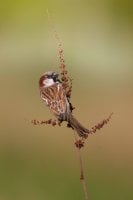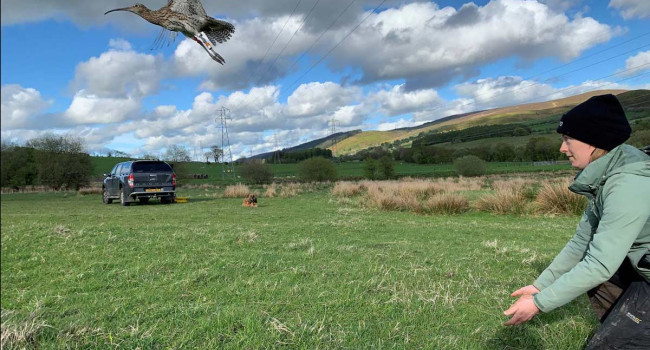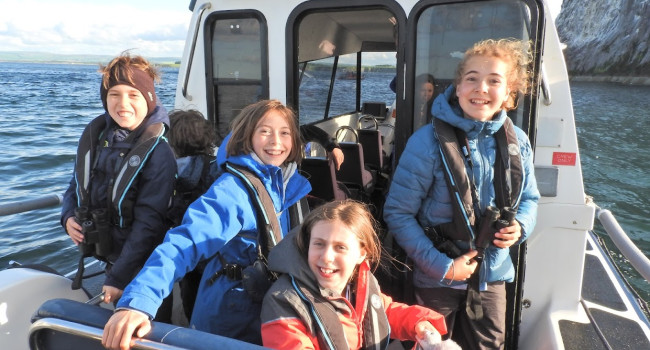Welsh House Sparrows buck the trend
01 Aug 2014 | No. 2014-48
House Sparrows, despite being in long-term decline across the UK, have increased in Wales by 96% between 1995 and 2012, as revealed in the Breeding Bird Survey (BBS) annual report. In contrast, the breeding population of Starlings in Wales is in long-term decline. The pattern for Starling is echoed across the UK as a whole with a decline of 51% across between 1995 and 2012.
The last 25 years have seen a marked decline in the abundance of House Sparrows in the UK. However, BBS trends show that this varies between regions and Wales appears to be good for House Sparrows! Declines of House Sparrows are greater in urban than rural areas. Since breeding performance is the same in both environments, factors affecting adult or juvenile survival (once they leave the nest) seem to be driving the declines. Further work is needed to explore these regional and habitat differences.
Population trends for 54 bird species in Wales have been calculated in the latest BTO/JNCC/RSPB Breeding Bird Survey annual report. This is the main scheme for monitoring the population changes of the UK’s common breeding birds.
The BBS report also highlights another trend that may be a surprise to many, given the large flocks seen at winter roost sites; the Welsh Starling population has declined by 70% between 1995 and 2012. Ringing-recovery data shows that first-year overwinter survival has probably driven the decline. Information from the Nest Record Scheme found increases in clutch size and fledglings per breeding attempt during the decline, also suggesting that the issue lies with juvenile survival rates after they leave the nest. The effects of agricultural intensification on food availability is thought to be the main factor in this decline.
Sarah Harris, BBS Organiser at the British Trust for Ornithology, said “Having spent many hours watching the large winter Starling murmuration in Aberystwyth, Wales, it is hard to believe the breeding population is struggling. On a brighter note, it is great to hear some good news regarding House Sparrow populations. The volunteer coverage increased again in Wales in 2013 and this is due to the continued dedication from existing volunteers, targeted volunteer recruitment by the BTO’s Regional Organisers, increased mentoring and workshops and funding from Natural Resource Wales to run the training programmes.”
Dr Siân Whitehead, Natural Resources Wales’ Terrestrial & Freshwater Ornithologist, said “These annual trends highlight the value of schemes such as the Breeding Bird Survey. Through the ongoing efforts of hundreds of volunteer birdwatchers, we can get a genuinely representative picture of what is happening to our bird populations. We may not always have a full understanding of what is causing changes in population size, but knowing whether a population is increasing or declining is the first step towards understanding what may be driving such trends.”
Ian Johnstone, RSPB Cymru Senior Conservation Scientist said “The report confirms that the numbers of these birds are changing dramatically, but the million dollar question is why? We need more research into these changes, so that wildlife organisations like us can make informed decisions to benefit these birds in Wales and the rest of the UK.”
Notes for Editors
- The latest report can be found at www.bto.org/volunteer-surveys/bbs/bbs-publications/bbs-reports
- The Breeding Bird Survey is run by the British Trust for Ornithology (BTO) and is jointly funded by BTO, the Joint Nature Conservation Committee (JNCC) (on behalf of the Council for Nature Conservation and the Countryside, Natural England, Natural Resources Wales and Scottish Natural Heritage), and the Royal Society for the Protection of Birds (RSPB).
- The BTO/JNCC/RSPB Breeding Bird Survey (BBS) is a national project aimed at keeping track of changes in the breeding populations of widespread bird species in the UK. The BBS involves around 2,800 participants who survey more than 3,600 sites across the UK, enabling us to monitor the population changes of over 100 bird species. Knowing to what extent bird populations are increasing or decreasing is fundamental to bird conservation. In 2013, Wales hit an all-time high with 331 BBS squares surveyed.
The information provided by the BBS provides a cornerstone for conservation action for birds in the UK.
This important survey is carried out by volunteer birdwatchers throughout the UK, who receive no financial reward or expenses for their efforts. We are indebted to them for their tremendous support.
- The BTO is the UK's leading bird research charity. A growing membership and up to 60,000 volunteer birdwatchers contribute to the BTO's surveys, collecting information that underpins conservation action in the UK. The BTO maintains a staff of 100 at its offices in Thetford, Stirling, Bangor (Wales) and Bangor (Northern Ireland), who analyse and publicise the results of surveys and projects. The BTO's work is funded by BTO supporters, government, trusts, industry and conservation organisations. www.bto.org
Contact Details
Sarah Harris
(Breeding Bird Survey Organiser)
Office: 01842 750050
(9am to 5.30pm)
Email: sarah.harris [at] bto.org
Paul Stancliffe
(BTO Media Manager)
Office: 01842 750050
(9am to 5.30pm)
Mobile: 07585 440910 (anytime)
Email: press [at] bto.org
Kelvin Jones
(BTO Wales)
Office: 01248 383285
Mobile: 07979713282
Email: kelvin.jones [at] bto.org
Dana Thomas
(Head of Public Affairs, RSPB Wales)
Office: 029 2035 3007
Email: dana.thomas [at] rspb.org.uk
Dr Siân Whitehead
(Terrestrial & Freshwater Ornithologist, Natural Resources Wales)
Office: 01248 387246
Email: sian.whitehead [at] cyfoethnaturiolcymru.gov.uk
Images are available for use alongside this News Release.
Please contact images [at] bto.org quoting reference 2014-48
The BTO has an ISDN line available for radio interviews.
Please contact us to book an interview
Office: 01842 750050







Share this page